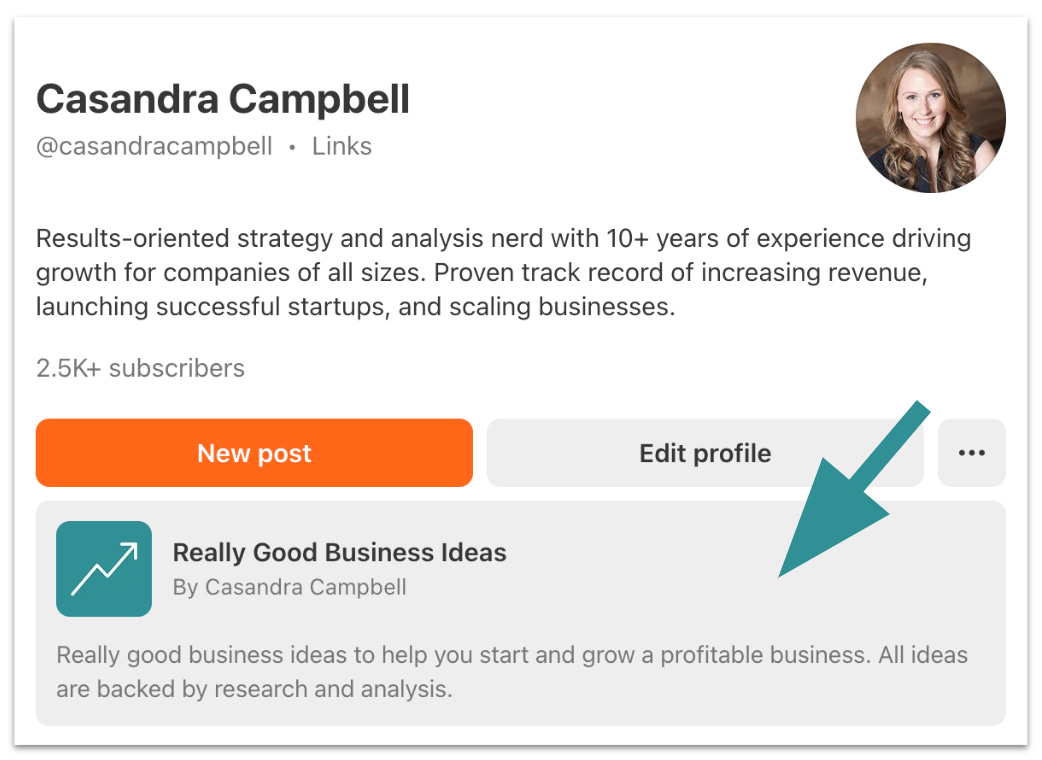How to Write the Perfect Substack Short Description
Three simple steps and eight examples to get inspiration from.
👋 Hey, I’m Casandra. I share research-backed business ideas to help you start and grow a business, including on Substack. This is a 🔒 Premium Edition 🔒 of Really Good Business Ideas.
Become a Premium subscriber to access the full Substack archive and Premium Perks like my direct support.
Almost all of your Substack subscribers will choose whether to subscribe after reading one thing: your publication’s short description.
While it may seem like an afterthought, your short description is crucial to growing your publication and building a strong brand.
For most people, it’s the first thing they’ll read about your publication, and what they read will determine if they decide to subscribe or not.
Your short description is your main sales pitch that will convert most of your subscribers so it’s essential that it adequately conveys your publication’s value.
Where Your Short Description Appears
Your short description will primarily appear in three locations.
Your Author Page

Your Welcome Page

Your Category’s Leaderboard Page

How to Add/Edit Your Short Description
Your short description can be added in your publication’s settings. Navigate to your publication’s “Dashboard” and then to “Settings.”
Then fill in your “Publication short description” in the “Basics” section.
Need feedback on your short description? Premium subscribers can book office hours or get one-on-one support through Substack chats.
3 Steps for Writing a Perfect Short Description
Your short description can only be up to 255 characters long so each word is important.
1. Gather Your Inspiration
The first step to writing a strong short description is to gather all the inputs you’ll need to come up with great ideas!
Describe Your Ideal Reader
Start by describing your ideal reader. Be as specific as possible. Gaining clarity on who you want to read your publication will make it easier to build a strong pitch that resonates with that audience.
Research Similar Publications
Next, research publications similar to yours by scrolling through the leaderboard page for the category that best matches your publication. Save any that stand out to you and note what they do well.
Develop Your Unique Selling Proposition
Finally, write your unique selling proposition. Your unique selling proposition should describe what makes your publication uniquely valuable. It will generally describe some combination of what you’re good at, what readers want, and what competitors lack.
In many cases, you will find that your unique selling proposition makes a solid foundation for your short description, but it’s best to continue with the process so you can be sure it’s as strong as possible.
2. Generate Ideas
Next, take all the work you did in step one and start developing some short descriptions.
Brainstorm as Many Ideas as Possible
Start by writing as many short descriptions as come to mind. Don’t worry too much about finessing them since you’ll have plenty of time to do that later.
Use AI to Expand Your Brainstorm
Next, use your favorite chatbot to expand your list of ideas. If you’re not sure what to use, Gemini is free and easy to access and my go-to for quick help with brainstorming.
Here’s a prompt you can use.
I’m brainstorming short descriptions for my Substack publication. My ideal reader is [fill in ideal reader description]. My unique selling proposition is [fill in your unique selling proposition]. These are some ideas I already came up with:
[Fill in short description one]
[Fill in short description two]
[Etc]
Can you suggest ten more options for me to consider?From there, you can tell your chatbot which ones you like and ask it to generate 10 more based on those.
When you’re finished, add all the newly generated ideas to your brainstorm list. It’s unlikely one of the AI-generated descriptions will be better than your own but you will probably find some words or phrases you want to explore.
3. Refine Your Ideas
Finally, refine your ideas and choose a winner.
Create a Shortlist
Create a shortlist of all of the best ideas you generated. If you want to take different parts of different ideas and mix them together now is a good time to do that.
Then, assess your shortlist by asking three questions:
Does it accurately convey what my publication is about?
Will it make my ideal reader say, “Heck, yes!”?
Is it too vague, or, conversely, does it assume readers already know me?
If any ideas don’t meet these criteria, discard them.
Test Your Top Choices
Now, take your top 3-5 and get outside feedback. If possible, ask people who are representative of your ideal reader which one excites them most. It may be someone you know, but it could also be strangers in an online community where your ideal reader hangs out.
Choose a Winner
Finally, using the feedback, choose a winner. If there are strong parts in different options and you want to recombine them, that’s ok too!
8 Great Short Descriptions Examples
The short description for
makes their value abundantly clear. A complete meal…that will impress…with minimal dishes…in under an hour? Sign me up!
The
has a clear audience (people doing B2B marketing for startups), promises actionable advice and frameworks, and builds credibility by mentioning it’s run by an ex-marketing exec.
This short description for
gets very specific in its niche by mentioning all the topics it covers specifically for people who identify as witches with ADHD.The
short description makes it clear they’re not just another football game recap blog. Their longform journalism goes deeper into the details and the stories behind the sport in both written and audio formats.The
short description is short and to the point. If you’re someone who’s fed up with the climate change situation but unwilling to ignore it, you’ll know you want to subscribe right away.
- ’s short description paints a clear picture of a reliable source for actionable gut microbombine information.
The short description for
makes it clear that their publication is a safe space for readers of any size who want to reject diet culture and anti-fat bias.
If you’re a metals and miners invesor,
makes their value clear when they promise the most comprehensive analysis around that you can use to inform your investments.
There are more topics than you can imagine out there!
Remember that not every publication will interest every reader, and that’s ok. The key is to make your publication’s unique value crystal clear to the people who will actually appreciate it!
To endless possibilities,
Casandra
PS. Need feedback on your short description? Premium subscribers can DM for support!
https://www.notion.so/Really-Good-Substack-Publication-Short-Descriptions-295efdd18cb48043b845d4a4ae133daf?source=copy_link
🎁 Premium Bonus: Really Good Substack Short Descriptions Database
Want to see what a great short description looks like in practice? I’ve built a database of hundreds of standout publication short descriptions across all categories: from technology to sports to education and more. Instead of starting from scratch, use this swipe file of examples to spark ideas.
This bonus is available exclusively for Premium subscribers.














